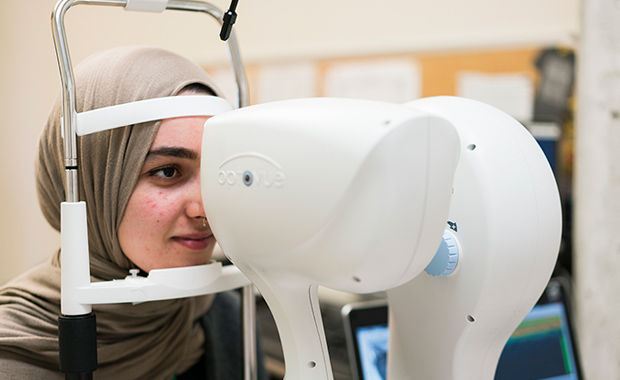New Treatment Improves Vision Health For Canadians With Glaucoma
Research and Innovations New treatment for glaucoma provides low risk and high recovery rate for patients.

laucoma is the leading cause of irreversible blindness worldwide, affecting more than 64 million people, including approximately 400,000 Canadians.
The Silent Thief of Sight
Glaucoma is a group of diseases that damage the eye‘s optic nerve. It develops slowly over time, often has no symptoms, and can go undiagnosed without proper checkups. If left untreated, glaucoma causes impaired vision and even blindness. It has been predicted that the number of people affected by glaucoma worldwide could grow to more than 76 million by the year 2020.
“Glaucoma is sometimes called ‘the silent blinder’ as patients normally don’t feel any difference during the early stages of the disease,” warns Dr. Hady Saheb, Assistant Professor of Ophthalmology and Director of Resident Research at McGill University. “But eye care professionals are able to detect early changes brought on by glaucoma and either prevent them from happening or from getting worse.”
“Because eye diseases like glaucoma are chronic and asymptomatic I can’t stress enough the importance of proper screening and monitoring,” agrees Dr. Ike Ahmed, a Lasik surgeon at TLC Laser Eye Canada renowned for his ground-breaking work in the diagnosis and surgical treatment of highly complex eye diseases. “While there may be no symptoms and no pain, the damage being done can be irreversible.”
Although damage caused by glaucoma can’t be reversed and even the development of the disease is not completely understood, we do know a major risk factor for developing glaucoma is increased eye pressure. This occurs when fluid in the eye – used to transport important nutrients to the lens and cornea – accumulates and cannot drain naturally, limiting a person’s vision and field of view
Recent advancements in glaucoma treatment have focused on relieving increased eye pressure using stents to drain excess fluids. A new treatment category, known as minimally invasive glaucoma surgery (MIGS), has been developed with a view to expanding access to treatment and reducing the complications associated with standard glaucoma therapies and surgeries.
“Although MIGS is a relatively new procedure and more study is necessary, it has already demonstrated its value,” says Dr. Ahmed. “There is a very significant percentage of the Canadian population that can benefit from MIGS.”
While standard glaucoma surgeries are often effective at lowering eye pressure and preventing progression of the disease, they are major surgeries with a long list of potential complications. Ophthalmologists are hesitant to recommend them except in the most serious of cases. The only other option previously available for more moderate cases was a combination of medications and daily eye drops.
“MIGS fills a gap between medication and more aggressive surgery,” say Dr. Saheb. “It fits nicely into the space where patients haven’t been treated adequately because eye drops are not quite doing the job, but surgery is too risky.”
Safer Surgeries with Fewer Complications
Before the MIGS group of operations, Canadians with glaucoma experienced reduced quality of life not just due to visual field loss, which can be associated with falls and accidents, but also because of the complications inherent to onerous medication protocols and invasive surgeries.
“The introduction of MIGS has allowed us to offer safer surgeries, earlier,” says Dr. Saheb. “We are now able to provide low-risk treatments to the majority of glaucoma patients, those in the more moderate portion of the disease spectrum, while reserving more invasive surgeries only for the most advanced patients.”
There are currently five MIGS procedures available, all of which work by using microscopic-sized equipment and tiny incisions to reduce pressure on the eye. Not only are the results impressive, the micro-invasive nature of the surgery reduces complications and allows for a rapid recovery. In one recent study, 72 percent of patients receiving treatment using microscopic stents no longer needed to take glaucoma medication after 12 months.
“Every doctor will have specific preferences for when patients can go back to regular activities,” notes Dr. Saheb, “but on average, the recovery time for MIGS is approximately 10 to 15 percent of that associated with more invasive procedures.”
MIGS is already improving the lives of Canadians, but it is not yet an option for every Canadian suffering with glaucoma. In fact, the rollout of this new technology has been somewhat uneven, with local availability often depending on a number of factors beyond the patient’s control.
“While MIGS is available in most provinces across the country it is mostly limited to glaucoma specialists and the biggest challenge to access remains the budgets allocated by individual hospitals,” says Dr. Saheb. “The scientific backing for the technology is there absolutely, but public funding to support the purchase and operation of the devices is lagging behind.”
As the scientific literature in support of MIGS continues to grow, there is hope that with increased awareness, and ultimately funding, MIGS can be used not only to improve the vision of tens of thousands of Canadians suffering with glaucoma, but also to reduce pressures on multiple aspects of our healthcare system.

